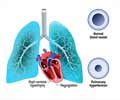Researchers have developed a unique new method to treat a specific group of patients who are at greater risk of rejecting a donor lung, allowing them to live longer after transplant without rejection.

Doctors identified three different groups of recipients who received a lung transplant from January 1, 2008 to December 31, 2011- patients who were highly 'sensitized' with antibodies to the lung donor, and at highest risk of rejection; a second group with antibodies which were not directed at, or specific to, the lung donor; and those who had no antibodies, and therefore had the lowest risk of rejection. Treatment regimes were adapted to each of these groups.
The difference amongst these three groups was the levels of antibodies or proteins in the blood which identify and attack foreign tissue, such as transplanted donor organs. It is seen that patients with the highest levels of antibodies are extremely hard to match to specific donors and have the highest rate of rejection. Previous studies have shown that their survival rate at 5-years has been as low as 30%, in contrast to 70-75% for those who had no antibodies and are easy to match to donors.
Senior author Dr. Lianne Singer said, "We were determined to solve this problem because those patients with high levels of antibodies would often wait on the transplant list for so long that they died. This is unacceptable. We needed to develop a treatment that is safe and effective for this specific group of patients."
After using the novel three-step method, doctors found that there was no difference in survival rates at 5-years between the group which had the most antibodies and the group which had none. They found that after treatment, the group with the highest antibodies had no differences in infections, rejection or function of the donor organ in comparison to the group which had no antibodies in the first place.
The TGH is the first group to put together elements of different approaches in a universally applicable protocol that can be easily used anywhere in the world. This method targets and reduces specific antibodies in patients once transplant is underway. Thus, lessening the risk to the specific donor lung- unlike other methods which lack this specificity and target a broader range of antibodies while a patient is still on the waiting list. Using various drugs and methods to first remove the antibodies from the recipient patient's blood, and then suppress the immune system from making them further, the method allows the donor lungs to function better once transplanted, rather than to be attacked and destroyed by a patient's antibodies.
Advertisement
Source-Medindia













